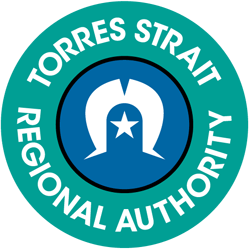Torres Strait Regional Authority facts for kids
 |
|
| Regional authority overview | |
|---|---|
| Formed | 1 July 1994 |
| Jurisdiction | Torres Strait Islands |
| Annual budget | $39.14 million AUD (2018–19) |
| Minister responsible |
|
| Regional authority executives |
|
The Torres Strait Regional Authority (TSRA) is a special group set up by the Australian Government in 1994. Its main job is to help the people living in the Torres Strait Islands. The TSRA has 20 people who are chosen by the island communities to represent them. Their most important goal is to make life better for the Torres Strait Islander people by helping with their economy, social well-being, and culture.
Contents
The Torres Strait Islands
The Torres Strait Islands are located north of Tropical Queensland's Cape York Peninsula. There are 274 small islands in total, but only 17 of them have people living on them. These islands are in the Torres Strait, which is the water between Australia and Papua New Guinea. Each community on these islands gets to choose one person to be a member of the Torres Strait Regional Authority.
Thursday Island (also called Waiben) and Horn Island (Nurupai) are the most famous islands in the Torres Strait. Life on the islands often follows old traditions, and fishing is a very important way for people to earn money. If you want to visit the more distant islands (not Thursday or Horn Island), you usually need to ask for permission from the Torres Strait Island Regional Council.
The five main groups of islands in the Torres Strait are:
- Northern Islands (like Boigu, Dauan, and Saibai)
- Eastern Islands (like Darnley, Murray, and Stephen)
- Western Islands (like St. Pauls, Kubin, Badu, and Mabuiag)
- Central Islands (like Yorke, Coconut, Warraber, and Yam)
- Southern Islands (including Thursday Island and other nearby islands, plus parts of mainland Australia)
A Brief History of the TSRA
The Torres Strait Regional Authority was created in 1994. It was set up separately from another group called the Aboriginal and Torres Strait Islander Commission. The idea was to provide better services and programs specifically for the Torres Strait Islander people living on the islands.
The TSRA has worked closely with the Island Co-ordinating Council to manage local resources. For example, in 1999, they started a plan to watch over and protect dugong and turtle populations in the waters around the islands.
In 2001, a study looked at how well the TSRA was doing. It found that finding jobs and having good housing were still big challenges for the islanders. However, in many other areas, like health, keeping their culture strong, and crime rates, the people on the islands were doing better than Torres Strait Islander people on the mainland or Australian Aboriginal people.
The TSRA also created something called the Bamaga Accord in 2001. This plan showed that the people of the islands wanted to have more control over their own local government and decisions.
In 2006, the TSRA and the Island Co-ordinating Council successfully asked the Australian Government for money. They received $300,000 to study how climate change might affect the six largest Torres Strait Islands.
A big achievement for the TSRA happened in 2010. After a long legal case that lasted nine years, the TSRA successfully claimed native title over a huge area of sea. This area was about 40,000 square kilometers between Cape York Peninsula and Papua New Guinea. It was the largest native title claim ever made in Australia's history. This meant that the traditional owners' rights to the sea were recognized.
In 2010, a group called the Torres Strait Territory Coalition was formed. This group included leaders from the Torres Strait Island Regional Council, the Torres Strait Regional Authority, and the Torres Shire Council. Their goal was to get official "Territory status" for the Torres Strait Islands, similar to how the Northern Territory or Australian Capital Territory are governed. This plan would have changed how the TSRA and local governments worked, but it has not happened.
How the TSRA is Governed
The Torres Strait Regional Authority is made up of 20 elected representatives. Their main job is to help improve the economy, social life, and culture of the Torres Strait people.
The TSRA board is led by a Chairperson and a Deputy Chairperson. As of August 2025, Napau Pedro Stephen is the current Chairperson. The daily work of the TSRA is handled by an Administration Department. This department is led by a Chief Executive Officer, who is currently Vonda Malone.
Chairpersons of the TSRA
- 1 July 1994 – March 1997: Getano Lui (Jnr)
- March 1997 – 19 April 2000: John Abednego
- 19 April 2000 – May 2004: Terry Waia
- May 2004 – November 2012: John Toshie Kris
- November 2012 – September 2016: Joseph Elu
- September 2016 – Present: Napau Pedro Stephen
See also
- Torres Strait Island Region (a local government area in Queensland)
- List of Australian government entities

